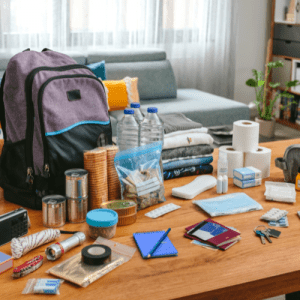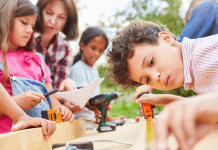With fires currently impacting San Diego and the recent devastation from LA fires, prioritizing disaster preparedness has never been more important.
Historically, the fire season in California was mainly from May through October, with peak rain season running from October through March. Some experts suggest that the fire season in California is now year-round.
Considering these circumstances, it is crucial to have your emergency and evacuation kit prepared and ready to go at a moment’s notice.
Below, we have outlined essential tools to help you create an Emergency Plan, build an Emergency Kit, stay connected, and access real-time updates through recommended apps.
 Here is a checklist from Ready.gov for your own emergency kit.
Here is a checklist from Ready.gov for your own emergency kit.
Basic Disaster Supplies Kit
To assemble your kit, store items in airtight plastic bags and put your entire disaster supplies kit in one or two easy-to-carry containers such as plastic bins or a duffel bag.
A basic emergency supply kit could include the following recommended items:
- Water – one gallon of water per person per day for at least three days for drinking and sanitation
- Food – at least a three-day supply of non-perishable food
- Battery-powered or hand crank radio and a NOAA Weather Radio with tone alert
- Flashlight
- First aid kit
- Extra batteries
- Whistle to signal for help
- Dust mask to help filter contaminated air and plastic sheeting and duct tape to shelter-in-place
- Moist towelettes, garbage bags and plastic ties for personal sanitation
- Wrench or pliers to turn off utilities
- Manual can opener for food
- Local maps
- Cell phone with chargers and a backup battery
Download the Recommended Supplies List (PDF)
Additional Emergency Supplies
Consider adding the following items to your emergency supply kit based on your individual needs:
- Prescription medications
- Non-prescription medications such as pain relievers, anti-diarrhea medication, antacids or laxatives
- Glasses and contact lens solution
- Infant formula, bottles, diapers, wipes, diaper rash cream
- Pet food and extra water for your pet
- Cash or traveler’s checks
- Important family documents, such as copies of insurance policies, identification, and bank account records, saved electronically or in a waterproof, portable container
- Sleeping bag or warm blanket for each person
- Complete change of clothing appropriate for your climate and sturdy shoes
- Household chlorine bleach and medicine dropper to disinfect water
- Fire extinguisher
- Matches in a waterproof container
- Feminine supplies and personal hygiene items
- Mess kits, paper cups, plates, paper towels and plastic utensils
- Paper and pencil
- Books, games, puzzles or other activities for children
Once you’ve packed your emergency kit, put it in a dry place close to your car, and re-check it every year to see if anything has expired.
It’s also smart to create a mini version of your home kit and keep it in your car.

Emergency Plan
Families should also create and practice an emergency plan so your family will know what to do in a crisis.
Thanks to the American Red Cross, you can create your emergency plan in just 3 steps.
Create Your Emergency Plan in Just 3 Steps (American Red Cross)
- With your family or household members, discuss how to prepare and respond to the types of emergencies that are most likely to happen where you live, learn, work and play.
- Identify responsibilities for each member of your household and how you will work together as a team.
- Practice as many elements of your plan as possible.
Plan for the emergencies that are most likely to happen where you live
Plan what to do in case you are separated during an emergency
- Choose two places to meet up:
- Right outside your home in case of a sudden emergency, such as a fire
- Outside your neighborhood, in case you cannot return home or are asked to evacuate
- Choose an out-of-area emergency contact person. It may be easier to text or call long distance if local phone lines are overloaded or out of service. Everyone should carry emergency contact information in writing and save on their cell phones. Make sure places where your children spend time also have these contact numbers, like at school or daycare.
- Your plan should account for family members who may live elsewhere during the year, such as military personnel on deployment, students away at college, or those who travel frequently.
- How will you need to adapt your plan if they are at home?
- What will you need to do differently if they are away?
Emergency Contact Card
Make cards for the whole family in case you are separated during an emergency.
Plan what to do if you have to evacuate
- Decide where you would go and what route you would take to get there, such as:
- A hotel/motel
- The home of friends or relatives a safe distance away
- An evacuation shelter
- Practice evacuating your home twice a year. Grab your emergency kit, just like you will in a real emergency, then drive your planned evacuation route. Plot alternate routes on your map in case roads are impassable. Make sure you have locations and maps saved on devices such as cell phones and GPS units and on paper.
- Plan ahead for your pets. Keep a phone list of pet-friendly hotels/motels and animal shelters that are along your evacuation routes. Remember, if it’s not safe for you to stay home, it’s not safe for your pets either.
Plan for everyone in your home
Some members of your household may need special accommodation during an emergency, which means planning ahead is even more crucial: Older Adults, People with Disabilities, Children and Pets.
Plan to let loved ones know you’re safe!
Download the FREE American Red Cross Emergency App
Find the Emergency App in the Apple Store » or Google Play » Aplicación de Emergencias – ahora disponible en español » también!
Download the Watch Duty App
Stay Safe From Wildfires When Seconds Count. Watch Duty, a 501(c)(3) nonprofit, alerts you of nearby wildfires and firefighting efforts in real time.
 Tips for Staying Connected from Cox Communications
Tips for Staying Connected from Cox Communications
In addition to your physical emergency kit preparation, it is also imperative that you remain informed and are able to check in with family and friends.
Our friends at Cox Communications have shared some great tips to remain connected during a natural disaster.
Other resources to protect your home and family:
-
People & pets
-
Papers, phone numbers & important documents
-
Prescriptions, vitamins & eyeglasses
-
Pictures & irreplaceable memorabilia
-
Personal computer, hard drive & disks
-
“Plastic” (credit cards, ATM cards) & cash
Wildfire safety steps to protect your home, loved ones, and the wider community.



















